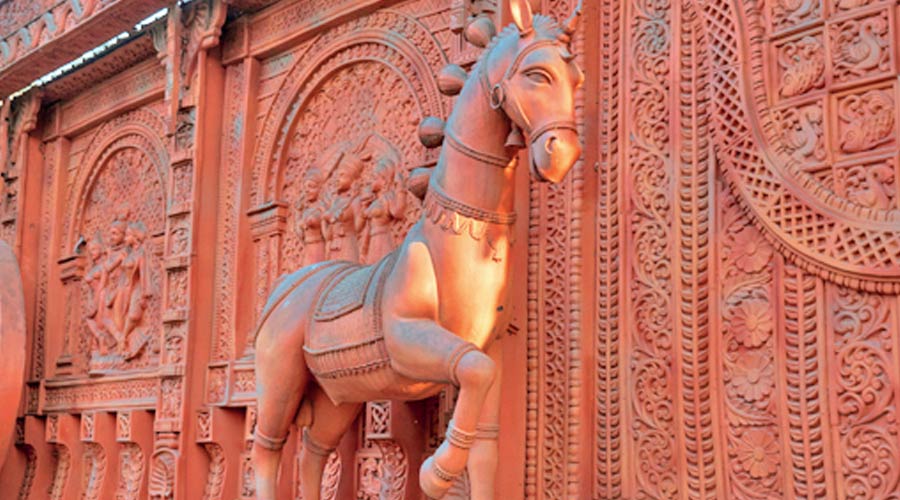Book: The Earthspinner
Author: Anuradha Roy
Publisher: Hachette
Price: Rs 599
The titles of Anuradha Roy’s novels often gesture beyond the humdrum realities of everyday life — An Atlas of Impossible Longing, The Folded Earth, Sleeping on Jupiter — and seem to point towards an amalgamation of the mundane and the cosmic. This balance of apparent opposites is a narrative characteristic Roy explores to the fullest in her latest and fifth novel, The Earthspinner.
The ‘Earthspinner’ of the title is Elango, a potter, and his disciple, Sarayu — or Sara — who had learnt the basics of pottery as a young girl from the artist who had a day job as an autorickshaw driver to supplement his meagre earnings. The Earthspinner also symbolizes the elemental forces, which continue to shape and restructure the world over millions of years, forming the oceans, mountain ranges, and continents. As Sara’s father reminds her, their existence is “not even a blink in the eye of planetary time”.
In the course of her studies at Oxford, a homesick and lonely Sara encounters the narrator’s lines from The Glass Menagerie: “I am the narrator of the play, and also a character in it.” Sara is also both a narrator and a character in the novel. In Roy’s expert hands, the prose becomes as malleable as clay, smoothly taking the shape of Sara’s journal entries in first-person; the third-person narration of events that had taken place almost half-a-dozen years ago; or, sometimes, short letters written to the agony aunt column of a newspaper. The disparate narrative units, however, never seem incoherent. Instead, a fine balance has been achieved through the consonance of themes. Indeed, for a novel of 220 odd pages, The Earthspinner manages to embrace an astonishing array of themes, ranging from loss, change, separation, communal and racist violence, love for humans as well as animals, art, and the elements. Elango, probably equally in love with a young Muslim girl called Zohra and a pup he found in a woodland whom he decides to call Chinna, embarks upon a journey to make a gigantic terracotta statue of a horse. The horse comes to Elango in a dream; it is the submarine mare which holds the fire of Siva’s tejas in its mouth. The myth of the submarine mare as narrated in the Siva Purana, the Matsya Purana and the Brihadaranyak Upanishad, among other scriptures, symbolizes an equilibrium of the opposing elements of fire and water. The elements play a major role in Roy’s narrative as well. The clay with which the earth-spinners create their pottery; the fire that burns them into terracotta sculptures and also burns down blocks of houses during a communal riot; the rain, sleet and flooding that Sara experiences and broods on at various crucial junctures of her life — all serve to place the narrative within the dual time-frame of the cosmic and the mundane and remind readers of the constant rhythm of creation and destruction.
The mare that Elango creates as a homage to his love for Zohra and Chinna carries on its body Kabir’s verses etched in Arabic by the blind calligrapher, Usman Alam, Zohra’s grandfather. Human pettiness and greed turn that magnificent artwork into an excuse for stirring communal trouble. Although the narrative is set in the late seventies and early eighties, it resonates with events taking place in contemporary India; the parallels are never forced, they come as naturally as a clay pot takes shape under the practised fingers of a potter.
The fluidity of Roy’s prose provides the characters with their unique speech and thought-rhythms. Sara’s loneliness, as she finds herself almost friendless in a foreign land, is expressed through various literary references. Verses from an Anglo-Saxon poem about a wandering warrior reminiscing about lost time encapsulate her alienation. The concluding section of the novel is narrated from the perspective of Chinna, now a senior dog content in his own territory, knowing that he is loved and cherished by his adoptive family. The literary and mythological references, coupled with Roy’s vivid descriptive prose, provide a rich texture to the narrative. The subtle moments of foreshadowing add to the narrative sophistication. A sleep-addled neighbour of Sara’s tries to calm Chinna by quoting lines from Tennyson’s “Break, Break, Break”— “But O for the touch of a vanish’d hand, / And the sound of a voice that is still!”— Chinna would never know the touch of Elango’s caressing hands after that night.
That balancing contrary forces is one of the central themes of the novel is made explicit in the epigraph from Kabir — “I’m grapefruit/ And I’m sweet lime/I’m Hindu/ And I’m Muslim.” The novel carefully embraces the oppositions and establishes balance, creating a finely-shaped artefact in the process. The bitter-sweet tastes of the lime and the grapefruit are what the novel leaves the readers with — a poignant sense of loss, profound memories to cherish, love that survives separation and violence, and the continuous upheavals, both in the bowels of the earth and in the lives of the inhabitants on its surface, are the stuff that life is made of.
The cover design by Monica Reyes Alvarez does the richness of the book justice by depicting the powerful image of a terracotta horse surrounded by flames. The horse is almost like a chthonic deity in its power, beauty and grandeur, a primal force that survives in the modern world through myths and narratives.










